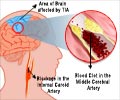It is reported that robot-assisted therapy has measurable benefits for patients with a weaker arm following a stroke.

The study authors, Keh-chung Lin, Yu-wei Hsieh, Wan-wen Liao - National Taiwan University, Ching-yi Wu - Chang Gung University, and Wan-ying Chang, Department of Physical Medicine and Rehabilitation, Taipei Hospital aimed to investigate how robot-assisted therapy helps arm function to improve after a stroke. They enrolled 20 patients in a study comparing robot-assisted therapy combined with functional training against an active control treatment group.
Stroke patients usually have difficulties transferring motor skills learned in therapy to their daily living environment because of cognitive deficits. The authors included real-world arm activity in the study by having patients wear accelerometers on both arms daily as they went about their normal tasks.
One of the key findings of the study was that robot-assisted therapy, when combined with functional task training, helps functional arm use and improves bimanual arm activity in daily life. Patients following a stroke often have weakness on one side of the upper body (hemiparesis), which can make daily life more difficult. Robotic rehabilitation is increasingly available, and holds promise for enhancing traditional post-stroke interventions. Because robots never tire, they can provide massive and intensive training in a consistent manner without fatigue, with programming precisely tailored to each patient's needs.
The rehab robots give sensorimotor feedback via visual and auditory feedback during training sessions, to facilitate patients' motor learning. However, although stroke patients' arm motor function and muscle strength have shown to improve during robot-assisted therapy in rehabilitation, previous studies suggested that these improvements did not carry through to the patients' daily lives. Some reasons for this might include a need for better measurement scales for patients' real life daily functions, as well as the fact many people compensate by using their non-impaired arm instead. By measuring both arms and following patients with the accelerometers at home, this study addressed these issues.Two further important findings of the study were that accelerometers are suitable tools to measure real-world arm activity in stroke patients; and that when combined with traditional clinical measurements these can enhance holistic understanding of a patients' life performance.
Accelerometers provide objective information about physical activity by measuring the acceleration of body movements. Stroke patients can easily wear the portable accelerometers like a wristwatch on each arm. This means researchers now have the accurate information they need to verify the intensity and amount of physical activity the patients actually do in real-life situations.
Advertisement
The mean ratio change of the robot-assisted therapy group was 0.047± 0.047, which beat the 0.007 ± 0.026 in the control group. The robot-assisted therapy group also handled more daily tasks with their impaired arm than the control group."In this study of rehabilitation approaches for patients with mild-to-moderate upper limb impairment six months after a stroke, we found significantly greater benefits of robot-assisted therapy compared with the active control group on the amount and quality of functional arm activity for the hemiplegic hand in the living environment," said Keh-chung Lin. "Moreover, robot-assisted therapy had superior benefits on improving bimanual arm activity," he added.
Advertisement
Source-Eurekalert














